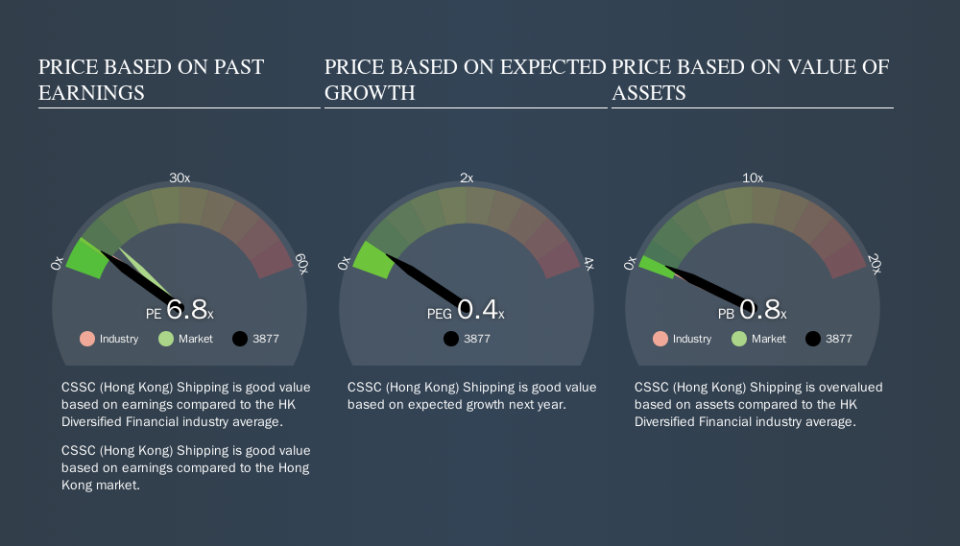Read This Before You Buy CSSC (Hong Kong) Shipping Company Limited (HKG:3877) Because Of Its P/E Ratio

Today, we'll introduce the concept of the P/E ratio for those who are learning about investing. We'll apply a basic P/E ratio analysis to CSSC (Hong Kong) Shipping Company Limited's (HKG:3877), to help you decide if the stock is worth further research. CSSC (Hong Kong) Shipping has a P/E ratio of 6.8, based on the last twelve months. In other words, at today's prices, investors are paying HK$6.8 for every HK$1 in prior year profit.
View our latest analysis for CSSC (Hong Kong) Shipping
How Do I Calculate A Price To Earnings Ratio?
The formula for P/E is:
Price to Earnings Ratio = Share Price ÷ Earnings per Share (EPS)
Or for CSSC (Hong Kong) Shipping:
P/E of 6.8 = HK$1.1 ÷ HK$0.16 (Based on the trailing twelve months to June 2019.)
Is A High Price-to-Earnings Ratio Good?
A higher P/E ratio implies that investors pay a higher price for the earning power of the business. That isn't a good or a bad thing on its own, but a high P/E means that buyers have a higher opinion of the business's prospects, relative to stocks with a lower P/E.
Does CSSC (Hong Kong) Shipping Have A Relatively High Or Low P/E For Its Industry?
The P/E ratio essentially measures market expectations of a company. The image below shows that CSSC (Hong Kong) Shipping has a lower P/E than the average (7.7) P/E for companies in the diversified financial industry.
This suggests that market participants think CSSC (Hong Kong) Shipping will underperform other companies in its industry. While current expectations are low, the stock could be undervalued if the situation is better than the market assumes. It is arguably worth checking if insiders are buying shares, because that might imply they believe the stock is undervalued.
How Growth Rates Impact P/E Ratios
Generally speaking the rate of earnings growth has a profound impact on a company's P/E multiple. When earnings grow, the 'E' increases, over time. Therefore, even if you pay a high multiple of earnings now, that multiple will become lower in the future. So while a stock may look expensive based on past earnings, it could be cheap based on future earnings.
Most would be impressed by CSSC (Hong Kong) Shipping earnings growth of 15% in the last year. And its annual EPS growth rate over 5 years is 4.9%. So one might expect an above average P/E ratio.
Don't Forget: The P/E Does Not Account For Debt or Bank Deposits
It's important to note that the P/E ratio considers the market capitalization, not the enterprise value. That means it doesn't take debt or cash into account. In theory, a company can lower its future P/E ratio by using cash or debt to invest in growth.
Such expenditure might be good or bad, in the long term, but the point here is that the balance sheet is not reflected by this ratio.
So What Does CSSC (Hong Kong) Shipping's Balance Sheet Tell Us?
Net debt totals a substantial 250% of CSSC (Hong Kong) Shipping's market cap. This level of debt justifies a relatively low P/E, so remain cognizant of the debt, if you're comparing it to other stocks.
The Verdict On CSSC (Hong Kong) Shipping's P/E Ratio
CSSC (Hong Kong) Shipping's P/E is 6.8 which is below average (10.7) in the HK market. The company may have significant debt, but EPS growth was good last year. If the company can continue to grow earnings, then the current P/E may be unjustifiably low.
When the market is wrong about a stock, it gives savvy investors an opportunity. If it is underestimating a company, investors can make money by buying and holding the shares until the market corrects itself. So this free visualization of the analyst consensus on future earnings could help you make the right decision about whether to buy, sell, or hold.
You might be able to find a better buy than CSSC (Hong Kong) Shipping. If you want a selection of possible winners, check out this free list of interesting companies that trade on a P/E below 20 (but have proven they can grow earnings).
We aim to bring you long-term focused research analysis driven by fundamental data. Note that our analysis may not factor in the latest price-sensitive company announcements or qualitative material.
If you spot an error that warrants correction, please contact the editor at editorial-team@simplywallst.com. This article by Simply Wall St is general in nature. It does not constitute a recommendation to buy or sell any stock, and does not take account of your objectives, or your financial situation. Simply Wall St has no position in the stocks mentioned. Thank you for reading.

